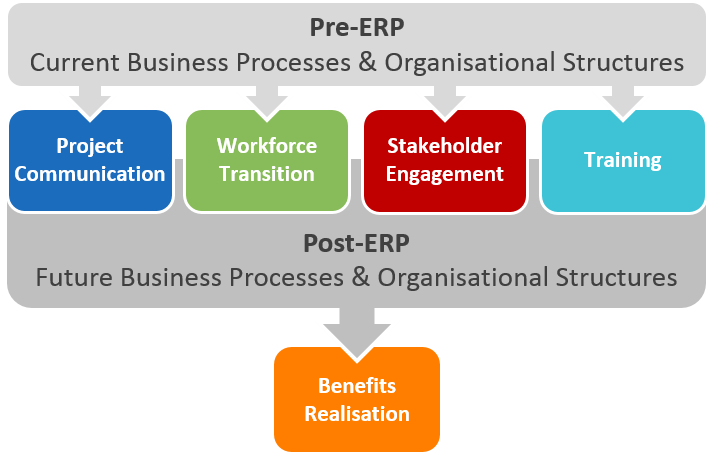Many ERP projects result in significant changes to business processes, work practises, roles and even organisational structures.
Why is Change Management important?
ERP change management is the process of dealing in a structured manner with the differences in business processes, work practises, roles and organisational structures that may occur following an ERP implementation project. If these changes are not managed in a controlled manner, it is likely that even a well-designed software solution based on good practise business processes will not be readily accepted by all users, which in turn is likely to prevent all of the intended business benefits from being realised for the organisation. Consequently, it’s hard to overstate the importance of change management in delivering a successful ERP project.
The Lumenia ERP Change Management Process
It is vital that change management and implementation of ERP take place in tandem. Our methodology addresses the challenges of process and organisational change in an ERP project using a structured approach to transitioning individuals, teams, and organisational units from the current state to a desired future state post-implementation. The Lumenia Change Manager works with business stakeholders, internal change agents and the ERP project team, utilising a methodology consisting of 5 inter-related streams as summarised in the diagram below.

How we add value
Often change management is seen as an intangible process, which is difficult to define and which, while important, does not have clear deliverables. We hold a very different view and believe that there are a number of ways that our structured approach to change management adds tangible value to ERP projects. These include:
-
Reduced Resistance to Change
Our process reduces resistance to change by working with stakeholders to frame the positives of the new ERP in ways that are relevant to them, and by being clear about any potential negatives and how these will be managed. Less resistance means people will more fully accept the new ERP and business processes.
-
More Effective Communication
Our approach ensures that communication to stakeholders is timely, effective and fully aligned with the ERP project objectives and plan. Better communication keeps people informed and helps to prevent misinformation about the ERP project and related process changes, which ultimately helps to garner support for the project.
-
Greater Benefits Realisation
People are key to fully realising all of the potential business benefits associated with ERP. Even the best designed ERP solution will not fully deliver all the benefits it could if users do not fully embrace the new technology and ways of working. Our process helps people to understand, accept and ultimately support the new ERP solution.
The different elements of our ERP change management process are described in more detail below.
Benefits Realisation
Benefits realisation is concerned with the identification of ERP project benefits and putting in place the structures and processes to help ensure that those benefits are realised. Lumenia’s benefits realisation stream begins by identifying and where possible quantifying expected ERP project benefits and developing a plan to ensure those benefits are realised once the implementation has been completed.
For quantifiable benefits, Key Performance Indicators (KPIs) are identified and the current baseline level of performance, where this exists, is recorded.
At key milestones during the project, requirements that are benefit enablers are reviewed to ensure the organisation is on track to realise the identified benefits.
Project Communication
Managing ERP project communication is concerned with ensuring that there is a structured process for imparting key project information to stakeholders or stakeholder groups.
Communication events will vary for each project but Lumenia’s approach will typically include a launch presentation and further updates at key ERP project milestones such as end of design, end of test and project go-live. Significant changes to business processes or organisational structures may also be communicated to the broader organisation as part of this stream. In between milestones, other less formal updates may also take place based on individual stakeholder or stakeholder group preferences.
Workforce Transition
Workforce transition management involves identifying the areas of the ERP project that will have an impact on workforce roles and responsibilities and guiding the organisation from the existing business processes, work practises and organisational structures to the new versions of each that will exist after the new ERP solution has been implemented. Often, organisations only begin to realise the importance of ERP change management when workforce transition planning starts.
In our process, the Lumenia Change Manager works with client stakeholders to identify the business processes and organisational structures which are most likely to experience change as a result of the implementation. The impact of these changes to current roles and jobs are assessed and a plan, aligned with the overall ERP implementation strategy and plan, is put in place to communicate these changes to the relevant stakeholders.
Where the changes to existing roles are significant, or where roles are to be discontinued or created as a result of the new system implementation, detailed job transition plans are developed and executed working in tandem with the client HR function.
Stakeholder Management
In the Lumenia process, the stakeholder management stream starts with the development of a stakeholder engagement plan. This usually includes interviews with key stakeholders to understand and document any concerns or suggestions they may have in relation to the ERP project, including with how ERP change management is being addressed. At this stage we also establish their preferences with regard to communication during the project lifecycle and discuss with them how best they can support the project objectives.
Meetings with stakeholder groups may be supplemented in some cases with surveys of the broader group membership so that attitudes to the project and understanding of the project objectives can be gauged and managed.
Training
Training is concerned with the identification of learning needs, development of a detailed training curriculum, production of training materials using the most appropriate delivery medium and the effective training delivery. Training is often taken for granted and underfunded in ERP projects, where in reality it Is a vital part of the ERP change management process.
For more details please go to the Training Section.

